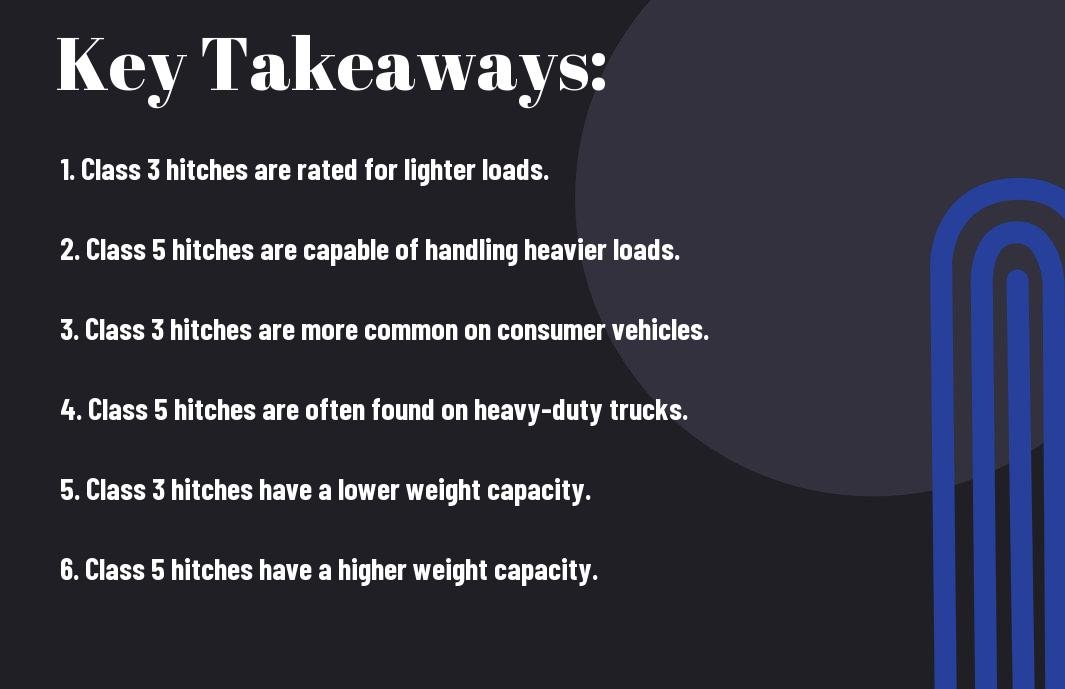Have you ever wondered about the differences between Class 3 and Class 5 hitches? If you’re in the market for a trailer hitch, it’s important to understand the distinctions between these two classes in order to make the right choice for your towing needs. One of the most significant differences between Class 3 and Class 5 hitches is their towing capacity. While Class 3 hitches are designed for lighter loads, Class 5 hitches are built to handle heavier, more demanding towing applications. Additionally, it’s important to note that compatibility with different vehicles varies between the two classes, so it’s crucial to consider this when making your decision. Understanding these differences can help you determine which type of hitch is best suited for your specific towing requirements.
Key Takeaways:
- Weight capacity: Class 3 hitches have a lower weight capacity than Class 5 hitches, making them suitable for smaller loads.
- Compatibility: Class 3 hitches are typically compatible with smaller vehicles such as SUVs and mid-size trucks, while Class 5 hitches are designed for heavy-duty trucks.
- Application: Class 3 hitches are commonly used for towing light trailers, bikes, and cargo carriers, while Class 5 hitches are ideal for towing large trailers, boats, and RVs.
- Construction: Class 3 hitches are made of lighter materials, while Class 5 hitches are constructed with heavier gauge steel for increased strength and durability.
- Mounting: Class 3 hitches typically use a bolt-on installation, while Class 5 hitches may require welding for secure mounting.
- Cost: Class 3 hitches are generally more affordable than Class 5 hitches due to the differences in weight capacity and materials used.
- Regulations: It’s important to ensure that the hitch you choose complies with your vehicle’s towing capacity and local regulations for safe and legal towing.

Class 3 Hitch
Clearly, when it comes to towing heavy loads, having the right hitch for the job is crucial. A Class 3 hitch is one of the most common types of hitches, known for its versatility and ability to tow moderate to heavy loads. If you’re considering a Class 3 hitch for your vehicle, it’s important to understand its specifications and typical uses to determine if it’s the right choice for your towing needs.
Specifications
One of the key features of a Class 3 hitch is its weight carrying capacity, which typically ranges from 3,500 to 8,000 pounds. This means that you can confidently tow trailers, campers, and other heavy loads without worrying about exceeding the hitch’s weight limit. Additionally, Class 3 hitches are designed to accommodate a variety of accessories, including bike racks, cargo carriers, and more. They are typically installed using a compatible receiver tube that is mounted underneath the vehicle.
Typical Uses
When it comes to towing, a Class 3 hitch offers versatility for a range of applications. Whether you’re towing a boat for a weekend trip, hauling ATVs for a day of adventure, or transporting heavy equipment for work, a Class 3 hitch provides the strength and reliability you need. With the ability to handle heavy loads, you can have peace of mind knowing that your hitch is up to the task. However, it’s important to ensure that you are aware of your vehicle’s towing capacity and any specific towing regulations in your area to ensure safe and legal towing practices.
Class 5 Hitch
Keep in mind that a Class 5 hitch is the highest weight carrying hitch available on the market. It is capable of towing heavy duty trailers, such as large campers, boats, or race car trailers. If you have a heavy load to tow, a Class 5 hitch is the way to go.
Specifications
With a Class 5 hitch, you can expect a higher weight capacity than lower classes. Typically, a Class 5 hitch has a weight carrying capacity of up to 17,000 pounds, with a maximum tongue weight of 1,700 pounds. This means you can safely tow some of the heaviest loads with ease. It is important to note that the specifications may vary by brand and model, so be sure to check the specific details for the hitch you are considering.
Advantages Over Lower Classes
The main advantage of a Class 5 hitch over lower classes is its higher weight carrying capacity. This means you can tow much heavier loads without compromising safety. Additionally, the larger size and sturdier construction of a Class 5 hitch provides added stability and durability when towing heavy loads. Whether you’re towing a large horse trailer or heavy construction equipment, a Class 5 hitch gives you the confidence and peace of mind that you can handle the job with ease.
Comparative Analysis
Now, let’s take a closer look at the differences between Class 3 and Class 5 hitches. The table below breaks down the key factors to consider when choosing between the two types of hitches.
| Factors | Class 3 Hitch |
| Towing Capacity | Up to 8,000 lbs |
| Weight Rating | 600 to 800 lbs tongue weight |
| Vehicle Compatibility | Mid-sized vehicles and light trucks |
Towing Capacity and Weight Rating Differences
When it comes to towing capacity and weight rating, the Class 5 hitch offers significantly higher capacity compared to the Class 3 hitch. With a Class 5 hitch, you can tow up to 12,000 lbs, while a Class 3 hitch is limited to 8,000 lbs. Additionally, the tongue weight rating for Class 5 hitches is also higher, typically ranging from 1,000 to 2,400 lbs, compared to 600 to 800 lbs for Class 3 hitches. This means that if you need to tow heavier loads, especially on a regular basis, a Class 5 hitch would be the more suitable option for you.
Compatibility and Vehicle Integration
When considering compatibility and vehicle integration, it’s important to know that Class 3 hitches are typically designed for mid-sized vehicles and light trucks, while Class 5 hitches are generally intended for heavy-duty trucks and commercial vehicles. If you have a heavy-duty truck or a vehicle that requires a higher towing capacity, a Class 5 hitch would be the best choice for you. However, if you have a mid-sized vehicle or light truck and do not need to tow extremely heavy loads, a Class 3 hitch may be more suitable for your needs.
Considerations When Choosing a Hitch
For all your towing needs, it’s important to choose the right hitch for your vehicle. There are a few key considerations to keep in mind when making this decision. By thinking about your vehicle requirements and intended towing use, you can ensure that you select the hitch that best suits your needs.
Vehicle Requirements
When choosing a hitch, the first thing to consider is the towing capacity of your vehicle. You must ensure that the hitch you select is compatible with your vehicle’s towing capacity. Failure to do so could result in dangerous situations on the road. Additionally, you should consider the type of receiver your vehicle is equipped with. Class 3 hitches typically use a 2-inch receiver, while Class 5 hitches use a 2-1/2 inch receiver. Make sure to check your vehicle’s receiver size before making a decision.
Intended Towing Use
Another important consideration when choosing a hitch is your intended towing use. If you’re planning to tow heavy loads on a regular basis, a Class 5 hitch may be the better option for you. On the other hand, if you only plan to tow light to moderate loads occasionally, a Class 3 hitch may be sufficient for your needs. Consider the weight of the loads you will be towing and choose a hitch that can handle it safely.
Conclusion
From above, you can see that the main difference between a Class 3 and a Class 5 hitch lies in their towing capacities and construction. While Class 3 hitches are suitable for light to medium-duty towing, Class 5 hitches are designed for heavy-duty towing applications. Additionally, Class 5 hitches are built with thicker, more durable materials to support their higher towing capacities. Ultimately, the choice between a Class 3 and Class 5 hitch will depend on the weight of the trailer or equipment you need to tow, so it’s important to carefully consider your towing needs before making a decision.
FAQ
Q: What is the difference between Class 3 and Class 5 hitch?
A: The main difference between Class 3 and Class 5 hitches is their towing capacity. Class 3 hitches are designed for light to medium-duty towing, typically ranging from 3,500 to 6,000 pounds, while Class 5 hitches are heavy-duty hitches, capable of towing up to 20,000 pounds or more.
Q: What vehicles are compatible with Class 3 hitches?
A: Class 3 hitches are commonly found on midsize trucks, SUVs, and full-size cars. They are suitable for towing small trailers, campers, and boats.
Q: What vehicles are compatible with Class 5 hitches?
A: Class 5 hitches are typically installed on heavy-duty trucks, commercial vehicles, and other large, heavy-duty vehicles. They are designed for towing heavy loads such as large trailers, equipment, and even other vehicles.
Q: Can a Class 3 hitch be used for heavy-duty towing?
A: It is not recommended to use a Class 3 hitch for heavy-duty towing. Exceeding the towing capacity of the hitch can lead to mechanical failure, accidents, and damage to your vehicle and trailer.
Q: Do Class 3 and Class 5 hitches require different installation methods?
A: Yes, the installation methods for Class 3 and Class 5 hitches are different due to their design and towing capacity. It is important to follow the manufacturer’s instructions and ensure that the hitch is properly installed by a qualified professional to ensure safe towing.
